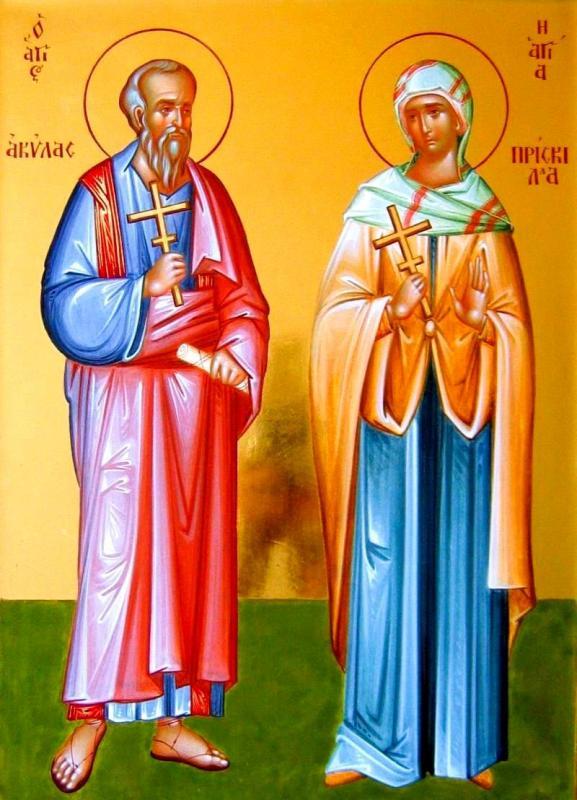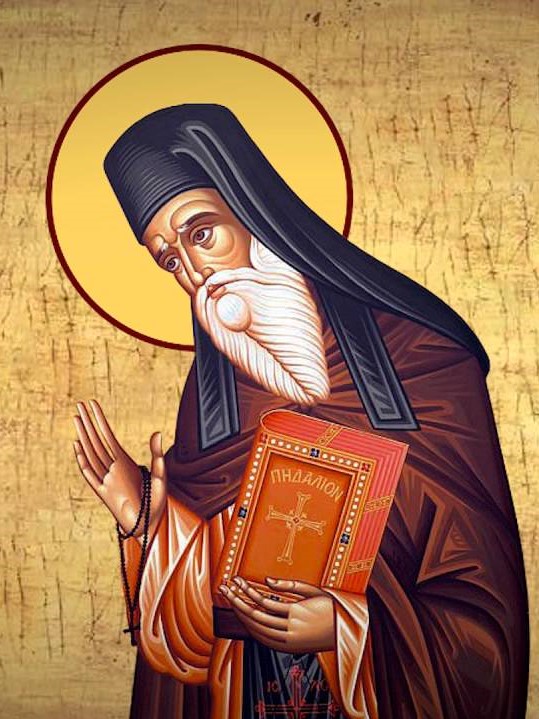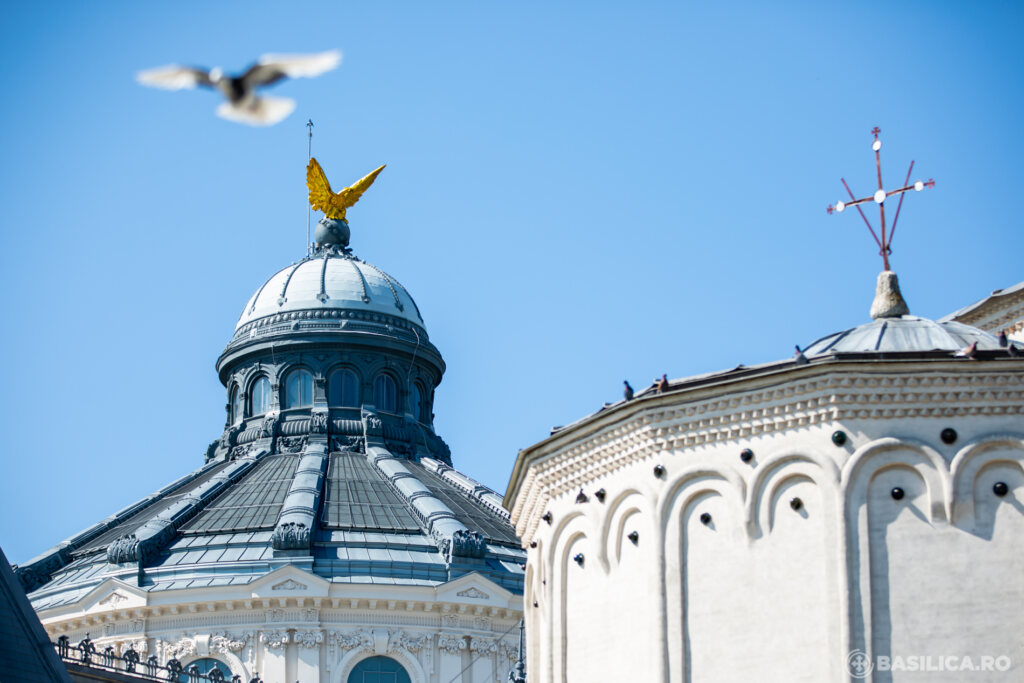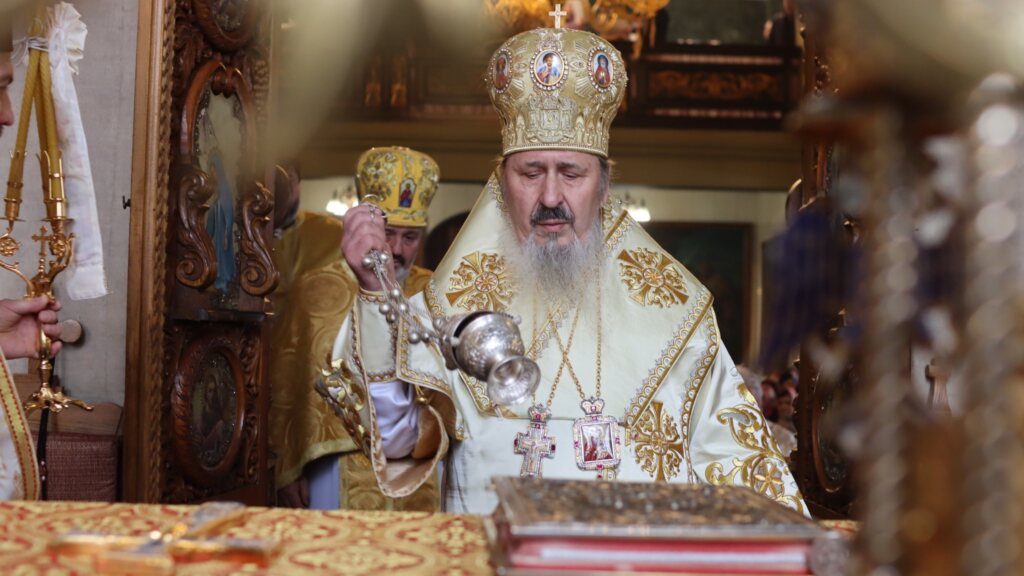Saint Aquila, Apostle of the 70
It is possible that he was a disciple of the Apostle Paul, a native of Pontus and a Jew, living in the city of Rome with his wife Priscilla (they are commemorated on February 13 on the Greek Calendar).
During the reign of the emperor Claudius (41-54) all the Jews were banished from Rome, so Saint Aquilla and his wife were compelled to leave. They settled in Corinth. A short while later, the holy Apostle Paul arrived there from Athens preaching the Gospel. Having made the acquaintance of Aquila, he began to live at his house and labored together with him, making tents.
Having received Baptism from the Apostle Paul, Aquila and Priscilla bacame his devoted and zealous disciples. They accompanied the apostle to Ephesus. The Apostle Paul instructed them to continue the preaching of the Gospel at Ephesus, and he himself went to Jerusalem, in order to be present for the feast of Pentecost.
At Ephesus, Aquila and Priscilla heard the bold preaching of a newcomer from Alexandria, the Jew Apollos. He had been instructed in the fundamentals of the Faith, but knew only the baptism of John the Forerunner. They called him over and explained more precisely about the way of the Lord.After the death of the emperor Claudius, Jews were permitted to return to Italy, and Aquila and Priscilla then returned to Rome. The Apostle Paul in his Epistle to the Romans recalls his faithful disciples, “Greet Priscilla and Aquila, my coworkers in Christ Jesus, who put forth their heads for my soul, whom I do not alone thank, but also all the Church of the Gentiles and the church of their household” (Rom. 16: 3-4).Saint Aquila did not long dwell in Rome: the Apostle Paul made him a bishop in Asia. Saint Aquila zealously labored at preaching the Gospel in Asia, Achaia and Heraklia. He converted pagans to Christ, he confirmed newly-converted Christians in the faith, he established presbyters and destroyed idols. Saint Priscilla constantly assisted him in the apostolic work. Saint Aquila ended his life a martyr: pagans murdered him. According to the Tradition of the Church, Saint Priscilla was killed together with him.
Troparion — Tone 1
As a disciple and companion of Paul / you received in your soul the grace of preaching. / You shone in the night of error and struggled for the Lord’s glory. / Sacred minister of the Savior, Aquila, we all acclaim you.
Holy Martyr Justus
Justus was a Roman soldier, to whom the Life-Creating Cross of the Lord appeared in a vision. Justus believed in Christ and gave away his possessions to the poor. By decree of the official of Magnesia, Justus was taken to trial as a Christian. After various tortures, the holy martyr was thrown into a fire and gave up his soul to God, but the flames did not harm his body.
Troparion — Tone 3
Your holy martyr Justus, O Lord, / through his sufferings has received an incorruptible crown from You, our God. / For having Your strength, he laid low his adversaries, / and shattered the powerless boldness of demons. / Through his intercessions, save our souls!
Saint Nicodemus of the Holy Mountain
He was born on the Greek island of Naxos in the year 1748, and was named Nicholas at Baptism. At the age of twenty-six, he arrived on Mount Athos and received the monastic tonsure in the Dionysiou monastery with the name Nicodemus.
As his first obedience, Nicodemus served as his monastery’s secretary. Two years after his entry into the Dionysiou monastery, the Metropolitan of Corinth, Saint Macarius Notaras (April 17), arrived there, and he assigned the young monk to edit the manuscript of the PHILOKALIA, which he found in 1777 at the Vatopedi monastery.
Editing this book was the beginning of many years of literary work by Saint Nicodemus. The young monk soon moved to the Pantokrator skete, where he was under obedience to the Elder Arsenius of the Peloponnesos, under whose guidance he zealously studied Holy Scripture and the works of the Holy Fathers.
In 1783 Saint Nicodemus was tonsured to the Great Schema, and he lived in complete silence for six years. When Saint Macarius of Corinth next visited Athos, he gave the obedience of editing of the writings of Saint Symeon the New Theologian to Saint Nicodemus, who gave up his ascetic silence and occupied himself once more with literary work. From that time until his death he continued zealously to toil in this endeavor.
Not long before his repose, Father Nicodemus, worn out by his literary work and ascetic efforts, went to live at the skete of the iconographers Hieromonks Stephen and Neophytus Skourtaius, who were brothers by birth. He asked them to help in the publication of his works, since he was hindered by his infirmity. There Saint Nicodemus peacefully fell asleep in the Lord on July 14, 1809.
According to the testimony of his contemporaries, Saint Nicodemus was a simple man, without malice, unassuming, and distinguished by his profound concentration. He possessed remarkable mental abilities: he knew the Holy Scriptures by heart, remembering even the chapter, verse and page, and he could even recite long passages from the writings of the Holy Fathers from memory.
The literary work of Saint Nicodemus was varied. He wrote a preface to the PHILOKALIA, and short lives of the ascetics. Among the saint’s ascetical works, his edition of Lorenzo Scupoli’s book, UNSEEN WARFARE is well known, and has been translated into Russian, English, and other languages. A remarkable work of the ascetic was his MANUAL OF CONFESSION (Venice, 1794, 1804, etc.), summarized in his treatise, “Three Discourses on Repentance”. His most edifying book CHRISTIAN MORALITY was published in Venice in 1803.
The saint also made great contributions by publishing liturgical books. Using materials from the manuscript collections of Mt Athos, he published sixty-two Canons to the Most Holy Theotokos under the title, NEW THEOTOKARION (Venice, 1796, 1849).
Saint Nicodemus prepared a new edition of the the PEDALION or RUDDER, comprised of the canons of the Holy Apostles, of the holy Ecumenical and Local Synods, and of the holy Fathers.
Saint Nicodemus had a special love for hagiography, as attested by his work, NEW EKLOGION (Venice, 1803), and his posthumous book, THE NEW SYNAXARION in three volumes (Venice, 1819). He completed a Modern Greek translation of a book by Saint Theophylact, Archbishop of Bulgaria, PAUL’S FOURTEEN EPISTLES in three volumes. Saint Nicodemus himself wrote AN INTERPRETATION OF THE SEVEN CATHOLIC EPISTLES (also published at Venice in 1806 and 1819).
The exceedingly wise Nicodemus is also known as the author and interpreter of hymns. His Canon in honor of the Mother of God “Quick to Hear” (November 9) and his “Service and Encomium in Honor of the Fathers who Shone on the Holy Mountain of Athos” are used even beyond the Holy Mountain. Some of his other books include the HEORTODROMION, an interpretation of the Canons which are sung on Feasts of the Lord and of the Mother of God (Venice, 1836), and THE NEW LADDER, an interpretation of the 75 Hymns of Degrees (Anabathmoi) of the liturgical book called the OKTOECHOS (Constantinople, 1844).
Troparion — Tone 8
By a flood of tears you made the desert fertile, / and your longing for God brought forth fruits in abundance. / By the radiance of miracles you illumined the whole universe! / O our holy father Νikόdēmos, pray to Christ our God to save our souls!







